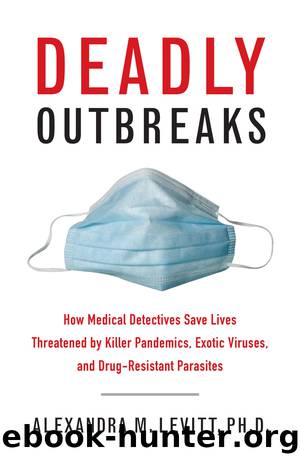Deadly Outbreaks by Alexandra M. Levitt

Author:Alexandra M. Levitt
Language: eng
Format: epub
Publisher: Skyhorse Publishing
Published: 2015-03-19T16:00:00+00:00
The Solution
It was the quiet week between Christmas and New Year’s. McDade’s custom was to use that week of work to “clean house” for the year, while no one else was around. He would finish up his paperwork and tidy up loose ends, undisturbed by colleagues or obligations.
On his own in the laboratory, he took out the box of guinea pig slides from August, the ones he had stained for rickettsiae by the Gimenez method. He viewed each one, section by section, very slowly, under the light microscope. Here and there he found a rod-like shape, just as he remembered. But then—there it was—he found a slide that had not just one rod, but a whole cluster of rod-shaped microorganisms. He went to the freezer, where he had carefully stored material from the first set of guinea pig experiments. He located a spleen-cell suspension from one of the guinea pigs that had been inoculated with lung tissue from a deceased Legionnaire. Then he sat down at his desk and thought over what he should do to re-evaluate his previous findings when he returned to the lab after the Christmas holiday.
He began on December 26. As part of his Q fever experiments, he had inoculated the guinea-pig-spleen suspension into embryonated eggs to see if anything would grow out, but nothing had. This time, he did the same procedure, but left out the bacteria-killing antibiotics. This time the embryos died in a few days. McDade smeared yolk sac tissue onto slides and stained them with rickettsial (Gimenez) stain. This time, they were loaded with rod-shaped bacteria! Was this evidence of contamination, or did it mean something?
He thought of an easy test. (Easy in the sense of simple and conclusive, not easy in the sense of not a lot of work.) He would find out whether LD patients had antibodies for the yolk-sac bacteria in their blood, using a standard laboratory technique called the indirect immunofluorescent assay (IFA). (Antibodies are special proteins in the blood produced by the immune system in response to microbes and other foreign bodies. Antibodies adhere to the microbes and foreign bodies, flagging them for ingestion by phagocytic cells.) He went to find Gary Noble, the head of the CDC influenza laboratory, and asked him for blood samples from the LD case-control study, including both case-patients and controls. If the bacteria in the yolks were the cause of LD, antibodies in blood samples from the LD patients—but not the control samples—would stick to them. It was a stroke of luck that Noble was also in the lab that week; he not only provided the samples but also encoded them so that McDade could test them without knowing which were from LD patients and which were from controls.
With the assistance of his long-time technician, Martha Redus, who returned to the laboratory after New Year’s Day, McDade smeared multiple spots of yolk sac tissue from the “no-antibiotics” experiment on microscope slides and used acetone to fix the tissue to the glass.
Download
This site does not store any files on its server. We only index and link to content provided by other sites. Please contact the content providers to delete copyright contents if any and email us, we'll remove relevant links or contents immediately.
Periodization Training for Sports by Tudor Bompa(8217)
Why We Sleep: Unlocking the Power of Sleep and Dreams by Matthew Walker(6660)
Paper Towns by Green John(5142)
The Immortal Life of Henrietta Lacks by Rebecca Skloot(4552)
The Sports Rules Book by Human Kinetics(4348)
Dynamic Alignment Through Imagery by Eric Franklin(4181)
ACSM's Complete Guide to Fitness & Health by ACSM(4023)
Kaplan MCAT Organic Chemistry Review: Created for MCAT 2015 (Kaplan Test Prep) by Kaplan(3972)
Introduction to Kinesiology by Shirl J. Hoffman(3745)
Livewired by David Eagleman(3732)
The Death of the Heart by Elizabeth Bowen(3583)
The River of Consciousness by Oliver Sacks(3574)
Alchemy and Alchemists by C. J. S. Thompson(3484)
Bad Pharma by Ben Goldacre(3399)
Descartes' Error by Antonio Damasio(3250)
The Emperor of All Maladies: A Biography of Cancer by Siddhartha Mukherjee(3115)
The Gene: An Intimate History by Siddhartha Mukherjee(3076)
The Fate of Rome: Climate, Disease, and the End of an Empire (The Princeton History of the Ancient World) by Kyle Harper(3036)
Kaplan MCAT Behavioral Sciences Review: Created for MCAT 2015 (Kaplan Test Prep) by Kaplan(2961)
